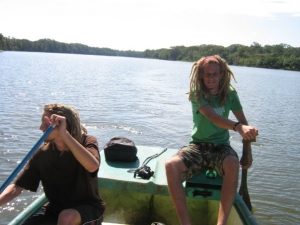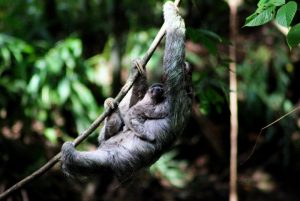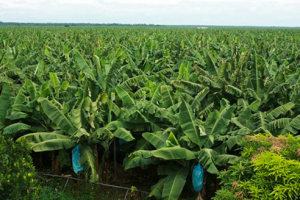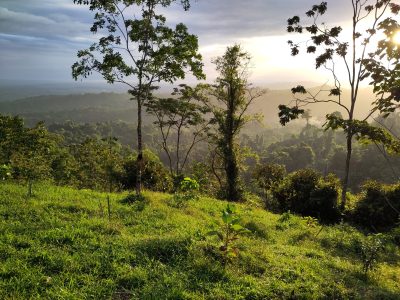20 years later: Dream, shadow, and struggle for the rainforest
The recent article in NRC about the banana industry in Costa Rica actually provides the perfect answer to the question I am often asked.
How did you ever come up with the idea of protecting the rainforest?
In this story, I will take you through how the idea to establish the Adopteer Regenwoud Foundation came about. It wasn’t so much a wild idea, but rather a necessity. Because I have seen with my own eyes how overwhelmingly beautiful the rainforest is—and how quickly it is disappearing at the same time. – Matthijs Bol –
First encounter with Costa Rica
When I was 19, I went backpacking to Costa Rica for the first time with my best friend Maarten. It was the country of our dreams, which we often saw in David Attenborough’s documentaries because of its beautiful nature and overwhelming biodiversity. We had to see and experience it with our own eyes. That’s why we signed up as volunteers for a project dedicated to protecting endangered sea turtles.
We ended up on an island surrounded by the impressive Pacuare River on the Caribbean coast. This is the river that is also mentioned by the NRC. A river reminiscent of the Amazon. What wilderness, what a wealth of natural beauty! The island was a strip seven kilometers long and less than three hundred meters wide. No more than thirty local people lived here.
Most of them lived off fishing and poaching turtle eggs. The project I worked for as a volunteer managed to convince these residents to become nature guides and thus protect the turtles instead of poaching them. It was a successful nature conservation project to which I returned many times as a volunteer and eventually became involved in for years as a board member.
I became friends with these remarkable people. They lived from and with nature. They told wonderful stories about their adventures and often took me into the wilderness.

The richness of nature
We could spend hours—sometimes even days—wandering through the jungle or floating down the rivers in our kayaks. We saw dolphins hunting in the river mouth, river otters playing on the banks, and giant crocodiles basking in the sun on the riverbed. Sometimes we had to duck because thousands of butterflies were using the river as a highway during their migration. Or because swinging monkeys were throwing branches down.
“It was the most beautiful nature experience I would ever have in my life.”
The downside: banana plantations and pesticides
But there was also a downside. During our trips, I noticed more and more that after a night of rain, there were dead fish everywhere in the river. We also regularly heard planes flying overhead in the middle of the jungle. I asked my local friends what kind of planes they were and what they were doing there. The answer was shocking: banana plantations.

Yellow sports planes flying low over banana plantations to spray pesticides. After a heavy rain shower, those pesticides wash into the rivers, resulting in countless dead animals floating to the surface. An oily substance remained on the water’s surface: a trail of death and destruction.
I immersed myself in the banana plantations and discovered that it was a huge industry. Thousands of hectares of plantations, where not a blade of grass grows: everything is sprayed to death to grow the perfect banana. And all this in places where there used to be rainforest.
The nature that I enjoyed so intensely was being destroyed because we humans want to eat cheap bananas. Why was nothing being done about this? Many people told me that it was better to be careful with criticism: the big fruit companies do not tolerate opposition. Later, I found out that not only was nature suffering enormous damage, but the local population was also developing serious health problems due to years of exposure to these pesticides.
The birth of Adopteer Regenwoud
In the years following our first visit to Costa Rica, I began studying Tropical Forestry and took every opportunity during my studies to do internships in Costa Rica. Together with my best friend Maarten van der Beek, I decided that something had to be done. Even if it was just a drop in the ocean.
We wanted to save as much rainforest as possible before the fruit companies could cut it down. That’s why we founded the Stichting Adopteer Regenwoud. Its mission: to purchase rainforest and transform it into a nature reserve, so that it is permanently removed from the commercial cycle.
Twenty years later
Twenty years have passed since then, and it pains me to read the article in NRC. Unfortunately, little has changed in all that time—I have seen it myself. The Pacuare River is still beautiful, but if only people knew how beautiful it was twenty years ago!The fact that this story is now being told in the media gives me hope. Hope that there will be more attention for the use of toxins in banana cultivation. Hope that measures will be taken by the government.
Wat jij kunt doen
But we, as consumers, can also make a difference. Every choice, no matter how small, counts. Buy an organic banana, or choose something closer to home—a delicious Dutch apple.The foundation has now protected more than 278 hectares of rainforest, including areas that are being reforested. A lot of research is being done into biodiversity and reforestation in collaboration with various local and international parties. To achieve the goal of 2000 hectares – which is the habitat of the jaguar – the foundation is still looking for new donors who will adopt a piece of rainforest themselves.
